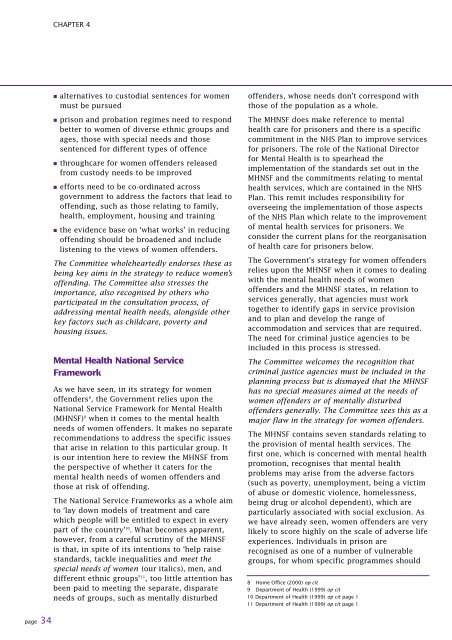Women who challenge - Nacro
Women who challenge - Nacro
Women who challenge - Nacro
- No tags were found...
You also want an ePaper? Increase the reach of your titles
YUMPU automatically turns print PDFs into web optimized ePapers that Google loves.
CHAPTER 4• alternatives to custodial sentences for womenmust be pursued• prison and probation regimes need to respondbetter to women of diverse ethnic groups andages, those with special needs and thosesentenced for different types of offence• throughcare for women offenders releasedfrom custody needs to be improved• efforts need to be co-ordinated acrossgovernment to address the factors that lead tooffending, such as those relating to family,health, employment, housing and training• the evidence base on ‘what works’ in reducingoffending should be broadened and includelistening to the views of women offenders.The Committee <strong>who</strong>leheartedly endorses these asbeing key aims in the strategy to reduce women’soffending. The Committee also stresses theimportance, also recognised by others <strong>who</strong>participated in the consultation process, ofaddressing mental health needs, alongside otherkey factors such as childcare, poverty andhousing issues.Mental Health National ServiceFrameworkAs we have seen, in its strategy for womenoffenders 8 , the Government relies upon theNational Service Framework for Mental Health(MHNSF) 9 when it comes to the mental healthneeds of women offenders. It makes no separaterecommendations to address the specific issuesthat arise in relation to this particular group. Itis our intention here to review the MHNSF fromthe perspective of whether it caters for themental health needs of women offenders andthose at risk of offending.The National Service Frameworks as a <strong>who</strong>le aimto ‘lay down models of treatment and carewhich people will be entitled to expect in everypart of the country’ 10 . What becomes apparent,however, from a careful scrutiny of the MHNSFis that, in spite of its intentions to ‘help raisestandards, tackle inequalities and meet thespecial needs of women (our italics), men, anddifferent ethnic groups’ 11 , too little attention hasbeen paid to meeting the separate, disparateneeds of groups, such as mentally disturbedoffenders, <strong>who</strong>se needs don’t correspond withthose of the population as a <strong>who</strong>le.The MHNSF does make re f e rence to mentalhealth care for prisoners and there is a specificcommitment in the NHS Plan to improve serv i c e sfor prisoners. The role of the National Dire c t o rfor Mental Health is to spearhead theimplementation of the standards set out in theMHNSF and the commitments relating to mentalhealth services, which are contained in the NHSPlan. This remit includes responsibility foroverseeing the implementation of those aspectsof the NHS Plan which relate to the impro v e m e n tof mental health services for prisoners. Weconsider the current plans for the re o rg a n i s a t i o nof health care for prisoners below.The Government’s strategy for women offendersrelies upon the MHNSF when it comes to dealingwith the mental health needs of womenoffenders and the MHNSF states, in relation toservices generally, that agencies must worktogether to identify gaps in service provisionand to plan and develop the range ofaccommodation and services that are required.The need for criminal justice agencies to beincluded in this process is stressed.The Committee welcomes the recognition thatcriminal justice agencies must be included in theplanning process but is dismayed that the MHNSFhas no special measures aimed at the needs ofwomen offenders or of mentally disturbedoffenders generally. The Committee sees this as amajor flaw in the strategy for women offenders.The MHNSF contains seven standards relating tothe provision of mental health services. Thefirst one, which is concerned with mental healthpromotion, recognises that mental healthproblems may arise from the adverse factors(such as poverty, unemployment, being a victimof abuse or domestic violence, homelessness,being drug or alcohol dependent), which areparticularly associated with social exclusion. Aswe have already seen, women offenders are verylikely to score highly on the scale of adverse lifeexperiences. Individuals in prison arerecognised as one of a number of vulnerablegroups, for <strong>who</strong>m specific programmes should8 Home Office (2000) op cit9 Department of Health (1999) op cit10 Department of Health (1999) op cit page 111 Department of Health (1999) op cit page 1page 34
















